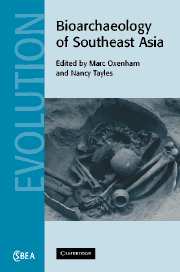Book contents
- Frontmatter
- Contents
- List of contributors
- Foreword: Emerging frontiers in the bioarchaeology of Southeast Asia
- Preface
- 1 Introduction: Southeast Asian bioarchaeology past and present
- Part I Morphological diversity, evolution and population relationships
- Part II Health, disease and quality of life
- Part III Conclusions
- 14 Synthesising Southeast Asian population history and palaeohealth
- Index
- References
14 - Synthesising Southeast Asian population history and palaeohealth
Published online by Cambridge University Press: 18 November 2009
- Frontmatter
- Contents
- List of contributors
- Foreword: Emerging frontiers in the bioarchaeology of Southeast Asia
- Preface
- 1 Introduction: Southeast Asian bioarchaeology past and present
- Part I Morphological diversity, evolution and population relationships
- Part II Health, disease and quality of life
- Part III Conclusions
- 14 Synthesising Southeast Asian population history and palaeohealth
- Index
- References
Summary
This is the first book specifically to address issues relating to prehistoric Southeast Asian skeletal biology. The principal aim of this volume was the examination of both the population history of Southeast Asia, in terms of origins and micro-evolutionary development, and the health and quality of life of these people. This chapter will discuss (a) the competing views or, alternatively, the consensus of opinion regarding the population history of the region; (b) descriptions of health and trends in health over time in Southeast Asia; and (c) the manner in which the current findings from both population history and palaeohealth can be synthesised in addressing questions surrounding economic and demographic change in this portion of the globe.
Neither the population history nor the evidence for health in Southeast Asia can be understood without reference to archaeological and linguistic evidence for the emergence of agriculture and the spread of Austroasiatic and Austronesian languages into the region. The current archaeological and linguistic consensus supports a hypothesis of agriculturally driven demic expansion or migration into Southeast Asia from a more northerly source (see Bellwood 2004). Higham (2001) noted that clearly a neolithic revolution occurred in the Yangzi valley in what is now China, beginning as early as 10,000 years BP. A southward expansion of agricultural communities, speaking Austroasiatic languages (a group that includes modern Vietnamese and Khmer), is now well documented into southwest China and on into Southeast Asia following major river systems such as the Chao Praya (into Thailand), Red (into northern Vietnam) and Mekong (into Laos, Cambodia and southern Vietnam) (Higham 2001).
- Type
- Chapter
- Information
- Bioarchaeology of Southeast Asia , pp. 335 - 350Publisher: Cambridge University PressPrint publication year: 2006
References
- 4
- Cited by



